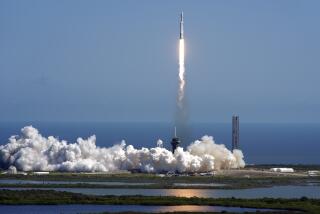New Mars Orbiter Embarks on Ambitious Fact-Finding Mission
- Share via
A school-bus sized spacecraft carrying the largest telescope ever installed in a planetary probe blasted off early Friday morning from the Cape Canaveral Air Force Station in Florida, beginning a seven-month journey to the Red Planet.
The Mars Reconnaissance Orbiter, 22 feet long and weighing more than two tons, will study the Martian surface and atmosphere from orbit, searching for sites where water may have once flowed, identifying potential landing sites for future surface craft and providing a powerful new relay station for transmitting data to Earth.
It is expected to return more data about Mars than all previous missions put together.
“We’re up, we’re on our way to Mars, and we have a spacecraft that is performing ... absolutely perfectly,” said James Graf, project manager for the mission at the Jet Propulsion Laboratory in La Canada Flintridge.
Mars was 72 million miles from Earth at launch time, but the craft will travel more than four times that distance to intercept the planet March 10, 2006. A 30-minute burn of its main engine will slow the craft enough to put it in a highly elliptical orbit that will range from within 100 miles of the surface to 20,000 miles away from it.
For the rest of the year, the orbiter will perform a delicate maneuver called aero-braking in which it will dip into the upper fringes of the atmosphere about 512 times until its speed has slowed enough to bring it into a nearly circular orbit 190 miles above the planet, where it will begin its four-year mission.
The orbiter carries six major science instruments, the largest of which is the High Resolution Imaging Science Experiment or HIRISE, operated out of the University of Arizona. HIRISE is a telescope with a 20-inch mirror, the largest ever sent out of Earth’s orbit, with a 1,200 megapixel digital camera.
The telescope will be able to resolve objects on the surface the size of a washing machine, said University of Arizona astronomer Alfred McEwen, the principal investigator for the instrument. The high-resolution imaging will allow researchers to map geological features and identify large rocks that would be hazardous to future landers.
“Engineers are much happier if they can actually see those rocks” in a potential landing site, McEwen said. “As a geologist, I am happy to see them for other reasons.”
A smaller imaging spectrometer will survey the surface in visible and infrared light to identify minerals, looking especially for those that are associated with water. Another, called the Context Camera, will take black-and-white pictures of a surface swath nearly 20 miles wide, identifying sites where high-resolution imaging will be used.
The Mars Color Imager will provide daily global views of the atmosphere and surface to provide weather maps, track surface changes and identify the composition of clouds.
The Mars Climate Sounder represents the third time researchers have tried to place an instrument in orbit to study water vapor, dust, ice and temperatures in the Martian atmosphere.
Similar instruments were on board the doomed Mars Observer and Mars Climate Orbiter spacecraft, both of which were lost in 1999. The Observer crashed into the surface; the Climate Orbiter apparently entered the atmosphere and burned up.
The sixth instrument is the Shallow Subsurface Radar, which uses ground-penetrating radar to look for ice under the surface. Other spacecraft now in orbit have observed broad areas of ice on the planet. “This will tell us whether they represent a thin veneer of ice or the tip of an iceberg,” Graf said.
To handle the data that will be generated, the orbiter has an antenna that is 9 feet in diameter, big compared with those on the Mars Odyssey and Mars Global Surveyor orbiters, which are only 3 feet across. The 3-foot antennas transmit data at a kilobit rate, Graf said, but the new one will allow transmission to be 10 times faster, about 5.6 megabits per second.
Data return in the past has been like “passing it through a straw,” he said. “Now we are opening up a fire hose.”
After its first two years of science studies, the orbiter primarily will serve as a relay station for data from the surface, first from the Phoenix, a stationary probe scheduled to land near the north polar ice cap in 2008, then from the Mars Science Laboratory, a roving probe due to arrive in 2010.
Although the newly launched orbiter was designed to last only through 2010, engineers say it has enough fuel to make it through 2014.
The mission is projected to cost about $720 million.
More to Read
Sign up for Essential California
The most important California stories and recommendations in your inbox every morning.
You may occasionally receive promotional content from the Los Angeles Times.










